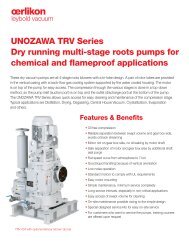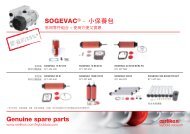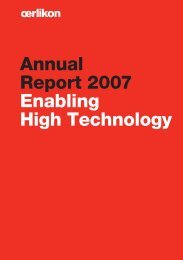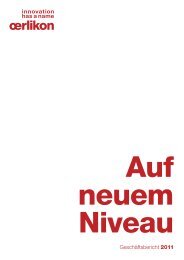Annual Report 2011 (5.07 MB, PDF-File) - Oerlikon
Annual Report 2011 (5.07 MB, PDF-File) - Oerlikon
Annual Report 2011 (5.07 MB, PDF-File) - Oerlikon
You also want an ePaper? Increase the reach of your titles
YUMPU automatically turns print PDFs into web optimized ePapers that Google loves.
Key Figures Group Notes OC <strong>Oerlikon</strong> Corporation AG, Pfäffikon<br />
Accounting principles<br />
Financial assets and derivative financial instruments: Marketable<br />
securities are held at fair values, with their values adjusted as required<br />
through the income statement. Gains or losses are measured by reference<br />
to fair value. Unquoted securities are valued by standard valuation methods,<br />
with value adjustments also through the income statement.<br />
Regular way purchases or sales of financial assets are recognized at settlement<br />
date. Financial investments held to maturity as well as loans and receivables<br />
are carried at amortized cost using the effective interest method.<br />
Gains and losses from changes in the fair value of financial investments<br />
available for sale are temporarily recorded in other comprehensive income<br />
until such investments are sold or disposed of, at which time the gains or<br />
losses are transferred to the income statement. Any loss from value impairment<br />
is immediately recorded in the income statement.<br />
Forward contracts and options are utilized systematically and mainly for the<br />
purpose of reducing business-related foreign currency and interest rate<br />
risks. These transactions are concluded with first-rate financial institutions<br />
and, as a general rule, have a term to maturity of up to 12 months. These<br />
derivative financial instruments are stated at fair value. If all requirements are<br />
fulfilled with regard to documentation, probability of occurrence, effectiveness<br />
and reliability of valuation, hedge accounting is applied in accordance<br />
with IAS 39. Until the hedged underlying business transactions are accounted<br />
for, the unrealized profits and losses resulting from the valuation of<br />
derivative financial instruments at fair value are recorded in other comprehensive<br />
income with no impact on the income statement.<br />
Trade receivables: Receivables are stated at the original invoiced<br />
amount less any necessary value adjustments for default risks. These risks<br />
are insured with third parties only in exceptional cases. Value adjustments<br />
are set at varying levels corresponding to risks recognized in the different<br />
Business Units.<br />
Inventories: Inventories of raw materials, purchased components and<br />
trade merchandise are carried at the lower of cost or net realizable value,<br />
using FIFO and weighted average cost valuation methods. Self-made components,<br />
work in progress and finished goods are carried at production<br />
cost. This includes all related material and labor costs as well as a reasonable<br />
allocation of indirect production costs. Recognizable reductions in value<br />
resulting from excess inventory, reduced replacement cost or sales price<br />
and similar are taken into account through appropriate write-downs of<br />
inventory items.<br />
Investments in associated companies: Investments in associated<br />
companies (20 to 50 % ownership of voting rights) are accounted for in accordance<br />
with IAS 28 (Accounting for Investments in Associates) using the<br />
equity method. The book value of the investment, initially its acquisition<br />
cost, is increased or reduced in response to the development in equity value<br />
of the associate, in proportion to the percentage held by <strong>Oerlikon</strong> Group.<br />
Property, plant and equipment: Tangible fixed assets are recorded<br />
at historical purchase or production costs, less necessary depreciation.<br />
Components of PP&E that have a differing useful life are recorded separately<br />
and depreciated accordingly (component approach). Depreciation is<br />
calculated on a straight-line basis according to the expected useful life of<br />
the asset, as follows:<br />
IT Hardware 3 – 7 years<br />
Company cars 4 – 7 years<br />
Trucks and electric vehicles 5 – 10 years<br />
Technical installations and machines 5 – 15 years<br />
Other operating and business equipment 3 – 15 years<br />
Central building installations 10 – 25 years<br />
Leasehold improvements Duration of rental<br />
contract (max. 20 years)<br />
or, if shorter, individual<br />
useful life<br />
Plant and administrative buildings –<br />
used operationally 20 – 60 years<br />
Estimated useful life and residual values are examined annually.<br />
97<br />
Fixed assets under financial leasing agreements are treated identically to<br />
fixed assets owned. Non-operating properties that are classified as held for<br />
sale are measured at the lower of their carrying amount or fair value less<br />
costs to sell, less any impairment.<br />
Intangible assets: Intangible assets are identifiable non-monetary<br />
assets without physical substance from which future economic benefits are<br />
expected to flow to the Group. Intangible assets are amortized on a straightline<br />
basis over their useful lives, where these can be clearly determined, for<br />
example software over two to three years or development costs over five<br />
years. In the case of intangible assets with indefinite useful lives, an impairment<br />
test of the asset value is conducted annually at the balance sheet<br />
date, or earlier on the occurrence of a triggering event.<br />
Discontinued operations and assets held for sale: An operating<br />
segment is reclassified into “discontinued operations” if its divestment is<br />
intended and if it fulfils the criteria for being classified as “held for sale”.<br />
Non-current assets held for sale are carried at the lower of their carrying<br />
amount or fair value less cost to sell, and any value impairments are recognized<br />
in the income statement.<br />
Liabilities<br />
Short- and long-term financial liabilities: Short- and long-term<br />
financial liabilities are initially valued at fair value less directly attributable<br />
costs. Subsequent valuation is at amortized cost adjusted using the effective<br />
interest rate method. The financial liabilities consist mainly of loans raised<br />
for past acquisitions.<br />
Short- and long-term provisions: Provisions are set up if the future<br />
outflow of resources is more likely than not and can be estimated reliably,<br />
for obligations arising from past events. Other provisions represent<br />
uncertainties, for which a best estimate is made in arriving at the amount<br />
reserved. The value of provisions whose expected maturity exceeds one<br />
year is discounted at normal market rates.<br />
Restructuring provisions: provisions are established in cases where a<br />
detailed restructuring plan exists and the Group has informed those concerned,<br />
or the restructuring process has started.<br />
Onerous customer contracts: provisions are established when unavoidable<br />
estimated costs to fulfill a contract exceed the related contract revenues. The<br />
difference is provided against income in the current period. When accounts<br />
are prepared the related risks are reassessed systematically by all Business<br />
Units and all costs are adjusted as required. This reassessment is based on<br />
the so-called “most likely outcome”, which uses assumptions regarding technical<br />
feasibility and timely realization of the projects and includes a quantification<br />
of the risks. The actual future obligation can vary from these estimates.<br />
Warranty provisions: provisions are established for known customer claims<br />
and also for potential warranty exposure.<br />
Product liability: provisions are established for known claims; potential exposure<br />
is not provided for.<br />
Provisions for pensions and other post-employment benefits:<br />
The net obligation for defined benefit and other post-retirement benefit<br />
plans has been calculated for each plan according to IAS 19 using the<br />
projected unit credit method as of the balance sheet date. The way these<br />
benefits are provided varies according to the legal, fiscal and economic<br />
conditions of each country, the benefits generally being based on the employees’<br />
remuneration and years of service. The obligations relate both to<br />
existing retirees’ pensions and to pension entitlements of future retirees.<br />
Actuarial gains and losses from defined benefit plans and deductions in<br />
connection with asset limitation are recognized in other comprehensive income,<br />
so they have no impact on the income statement, and are presented<br />
in the consolidated statement of comprehensive income.











